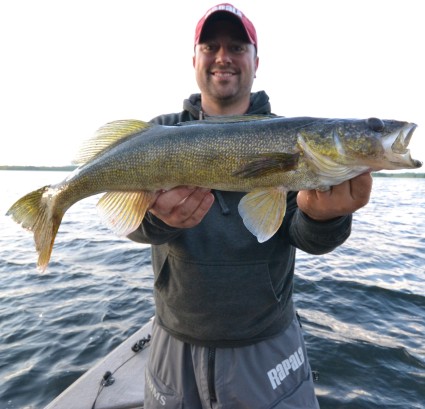
First Fish of the Day
Mid-summer walleyes can be tough customers, but there are always things you can do to improve your catch rate, even when the bite gets tough. In the inaugural edition of the In-Depth Outdoors Magazine, I spent some time in the Dog Days Walleyes Article detailing my approach to pulling spinners for finicky fish mid-summer on larger lakes like Leech, Mille Lacs, and Lake of the Woods. These large water bodies offer expansive flats, and large (a relative term) pieces of structure for which to pull crawler harnesses endlessly. But what about smaller bodies of water where short runs and small points, humps, or islands make trolling spinners somewhat impractical? Jig you say, slip-bobber you say. All good techniques to put fish in the boat in such situations, but what if fish are scattered here and there on the tops of these pieces of structure? Not strewn along a half mile stretch of gravel bar, but spread out on top of a 100 yard chunk of underwater real-estate?
Live-bait rigging continues to be one of my favorite techniques to present mid-summer eyes their meal of choice. I’m not alone, and for good reason. When fish have pushed into 20-30FOW and are relating to structural lake-bottom elements, fishing with other methods becomes difficult. Jig fishing, especially with the wind that likes to concentrate these fish, gets tough. Bobbering is great for precision, small locations, and/or extremely clear water where a dangling leech can be visible for a good distance. Casting cranks, lipless or otherwise, is a great technique that works well especially early and late season for aggressive fish. However, rigging in my boat continues to be more versatile deep into the summer months with eyes that range from fish-fry material, to solid and chunky fish that anyone would be proud to take a picture with. This is especially true when talking about the scores of small natural lakes that are much more common in number and widespread in location throughout the Midwest than the large walleye-factory destinations that get so much press.
The Pattern:
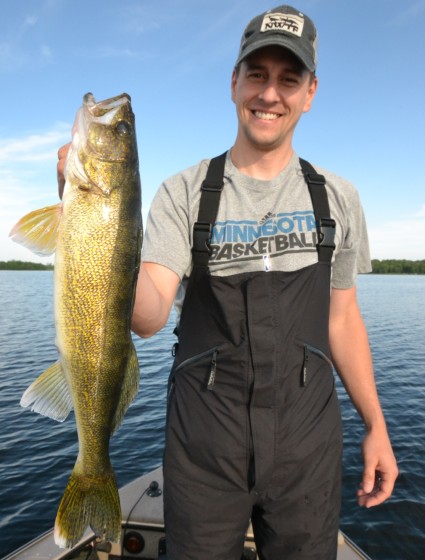 Even though we were either side of the full moon this weekend, the day bite was good on Friday early because of the wind. Fishing early has always paid dividends for me during this time of year, as fish really take advantage of narrow feeding windows. Provided you’ve found fish, being there at the right time can make all of the difference this time of year. As can your choice of bait. While driving off the edge of structure into the mud a few times, I saw some pretty prolific hatches coming just off of the lake-bottom. Crawlers have always produced better for me than leeches during big hatches. Though I’m not sure why, whether it’s profile, color, or both, that proved again to be true in my boat. When pinched off just past the collar, a fresh nightcrawler really out-shined leeches of all sizes. I tend to rig these on larger sized hooks, as big as size 2, to avoid fish being deep hooked. Though smaller sizes can really make a big difference when fish are neutral to negative, if I’m fishing something in a size 6 or 8, I’ll give the fish very little time to take the bait. We can run 4 lines in the boat pretty effectively by having the two lines in the front run ¾ oz. VMC Switch-It Slip Sinkers, and the two in the back run ½ oz weights. I’m a big fan of running contrasting colors at the business end between beads and hooks, and use Sufix 832 20/6 for a mainline, and 10lb Sufix Floro Inivisiline as my leader. A 6 foot leader is always preferred, especially when trying to net larger fish, but someone in the boat is always running a 10 foot leader to see its effect if any. Much like pulling cranks, this is no static situation. Rather, we’re switching bait, colors, hooks, bead sizes/colors, and also tweaking smaller and less tangible variables like dragging vs. no-dragging the sinker, tug-of-war with the fish vs. first tap, giving the fish more time vs. less time, etc. In rocks, we’ll add a small float, even ½ a float to combat the sinking properties of the floro leader.
Even though we were either side of the full moon this weekend, the day bite was good on Friday early because of the wind. Fishing early has always paid dividends for me during this time of year, as fish really take advantage of narrow feeding windows. Provided you’ve found fish, being there at the right time can make all of the difference this time of year. As can your choice of bait. While driving off the edge of structure into the mud a few times, I saw some pretty prolific hatches coming just off of the lake-bottom. Crawlers have always produced better for me than leeches during big hatches. Though I’m not sure why, whether it’s profile, color, or both, that proved again to be true in my boat. When pinched off just past the collar, a fresh nightcrawler really out-shined leeches of all sizes. I tend to rig these on larger sized hooks, as big as size 2, to avoid fish being deep hooked. Though smaller sizes can really make a big difference when fish are neutral to negative, if I’m fishing something in a size 6 or 8, I’ll give the fish very little time to take the bait. We can run 4 lines in the boat pretty effectively by having the two lines in the front run ¾ oz. VMC Switch-It Slip Sinkers, and the two in the back run ½ oz weights. I’m a big fan of running contrasting colors at the business end between beads and hooks, and use Sufix 832 20/6 for a mainline, and 10lb Sufix Floro Inivisiline as my leader. A 6 foot leader is always preferred, especially when trying to net larger fish, but someone in the boat is always running a 10 foot leader to see its effect if any. Much like pulling cranks, this is no static situation. Rather, we’re switching bait, colors, hooks, bead sizes/colors, and also tweaking smaller and less tangible variables like dragging vs. no-dragging the sinker, tug-of-war with the fish vs. first tap, giving the fish more time vs. less time, etc. In rocks, we’ll add a small float, even ½ a float to combat the sinking properties of the floro leader.
The Hookset:
The moment of truth for a live-bait rigger comes with the hookset. In observing a pile of different methods, some effective, most not, I keep coming back to a number of basics. I live by the mantra that hooksets are free and looking stupid is way better than catching less fish, so I’m constantly dropping back a bit of line to see if it’s a fish running or if I hit rocks, a clam-shell, or another fish with the sinker in a funny way. With the bail open and the line over your index finger, when you feel a bite, I try to drop it off of my finger immediately. I pay out a few pulls of slack, then observe the line on the surface. If it disappears rapidly the fish is running and usually has the bait pretty well. I give the fish a few more pulls of slack (just so he doesn’t catch me before I’m ready to set it), then I point the rod back at the fish, pick up the slack and sweep forward a good distance, ready at the reel to pick up any slack my rod didn’t. For more subtle pickups, I perform the hookset much the same, this time feeling for the head-shake, weight, or anything not “rock-like” before I drive the hook home. The most common mistakes I see are failing to take up enough slack, not pointing the rod to the fish and sweeping far enough forward, and forgetting to reel in slack after this process has been carried out. Fish can run towards you, and when you pick up for the hookset and feel sinker, then set it with slack between sinker and hook-end, it’s easy to lose fish that way too. Continually reeling after the initial sweep can help to counter that effect.
Location:
On this day, fish were loosely scattered out deeper, but wind brought them up on a hard-bottom underwater point in 18-22FOW to feed. Fish off the edge were not as willing, but up on top there were some active ones to be found. We also found fish on windblown inside turns and tips of small humps. From experience and looking at some of these spots over the years, all of them have clams. Not just clams strewn on top of the structure, but clams in key locations on the structure. Some of the most predictable locations I fish for walleyes every year are on spot-on-the-spot clam-beds on structure. How do I know this? Dropping an underwater camera is the surest way to find out. It amazes me the number of folks who own a camera for winter fishing, that fail to use it during the summer. A great deal can be learned about not just bottom composition and structure, but why certain structural elements are only good in specific locations. A rock-pile is not a rock-pile is not a rock pile!
It’s a basic technique, yet I’m always surprised how even the easiest methods can hold slight nuance which makes the difference on tough bites. Enjoy the summer and get out there!
Joel
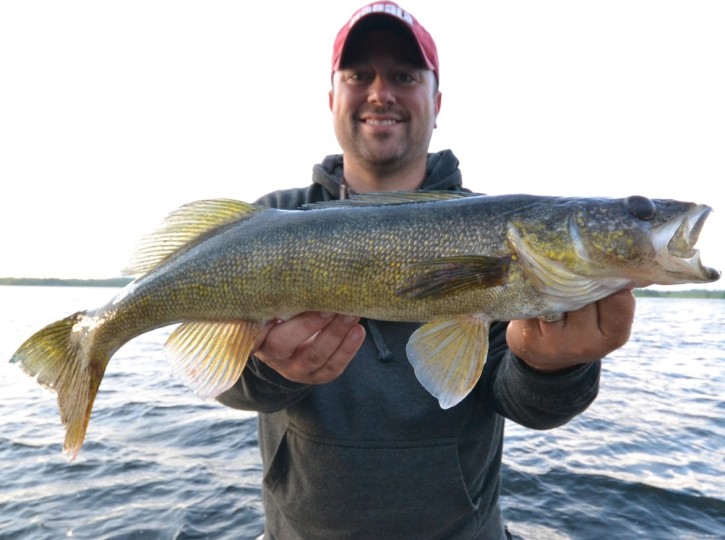
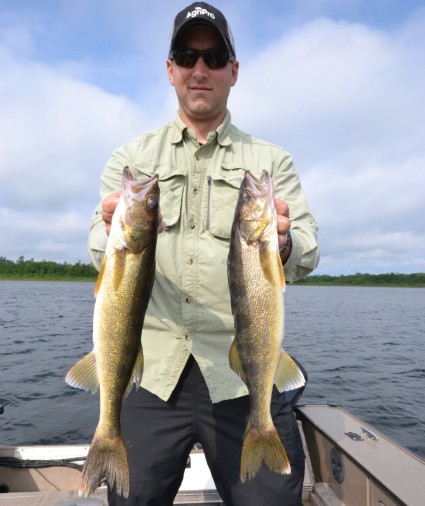
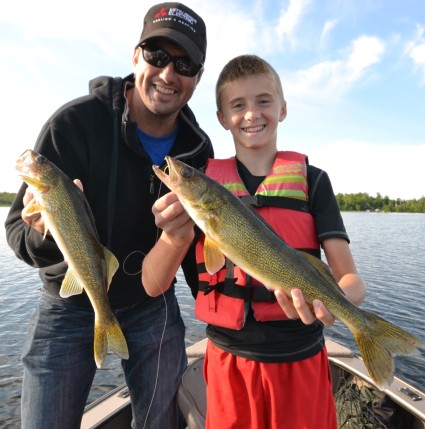
Heading up to longville in few hours. Cant wait!!
Well done, sir! You ready to trade in those livebait rigs for heavy leaders and pike baits? I’m heading north and need a fishing partner AKA “net man!” The co-pilot seat is yours if you can make it.
@jamesholst – In-in-in! I keep bags half-packed for such occasions!
@joeforbrook – Let us know how you do! After ‘eyes? Hopefully that information holds and you get some good weather to work with. Forecast looks favorable!
Joel
Great Job Joel !!!
Good luck on the Monster Pike Guys !!